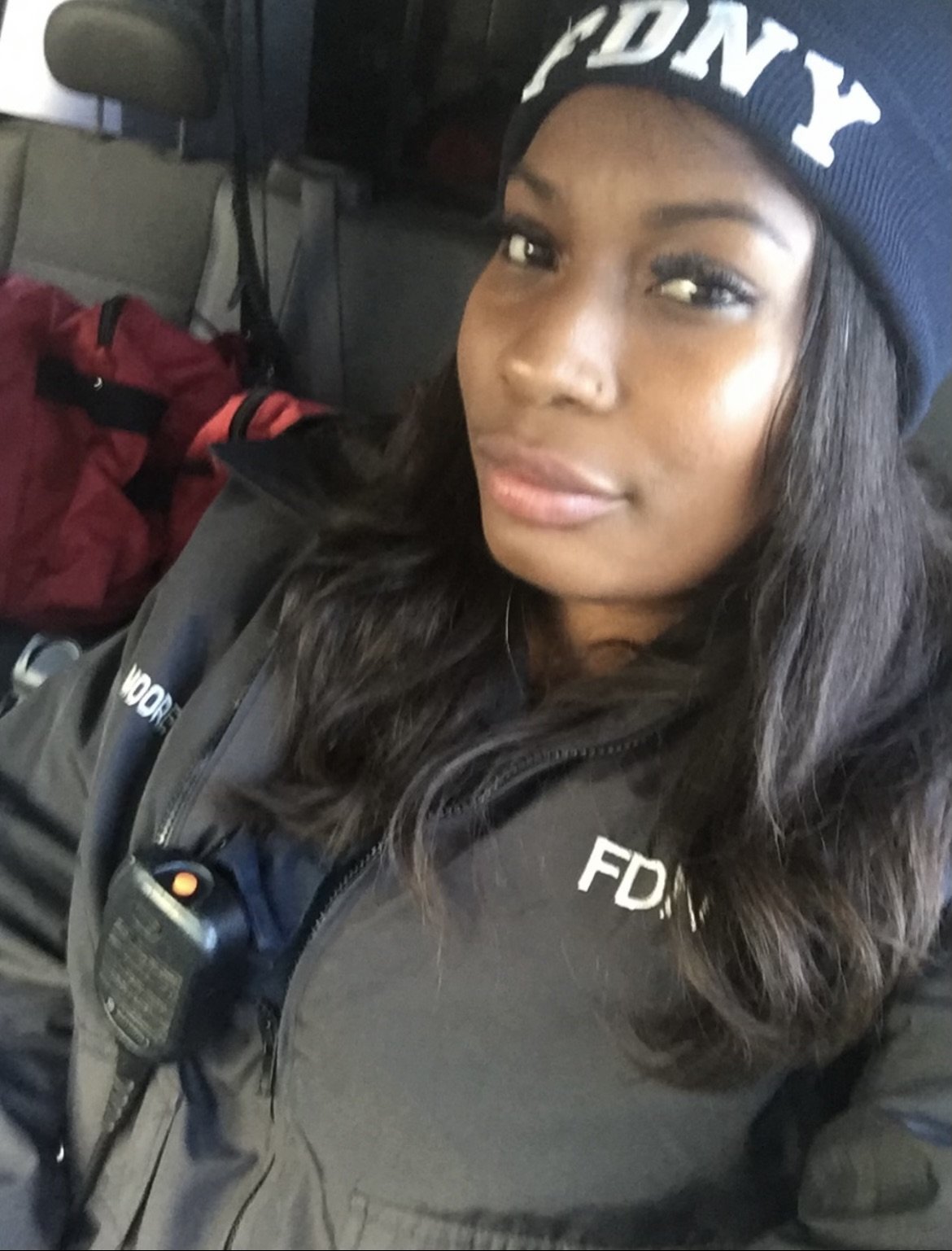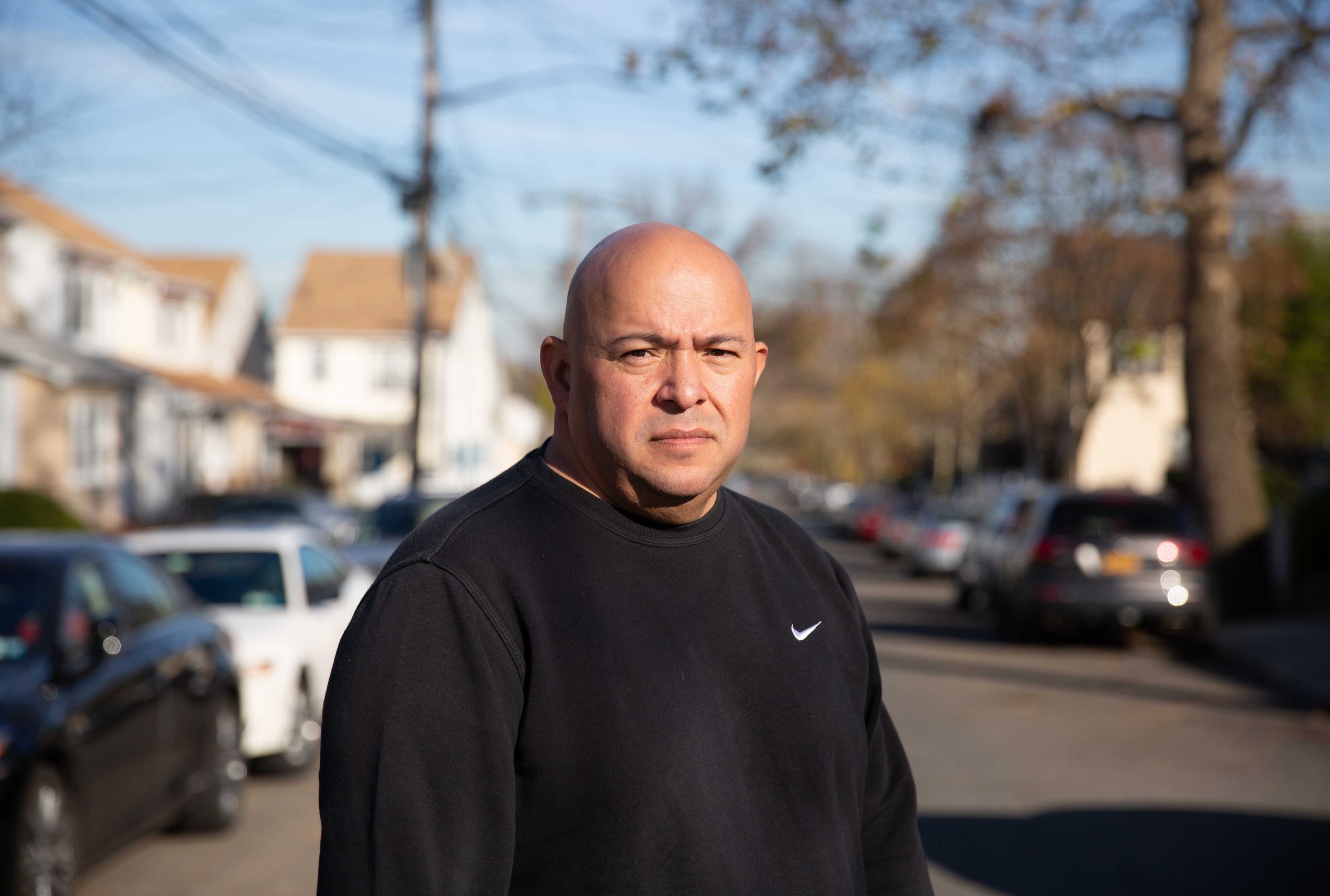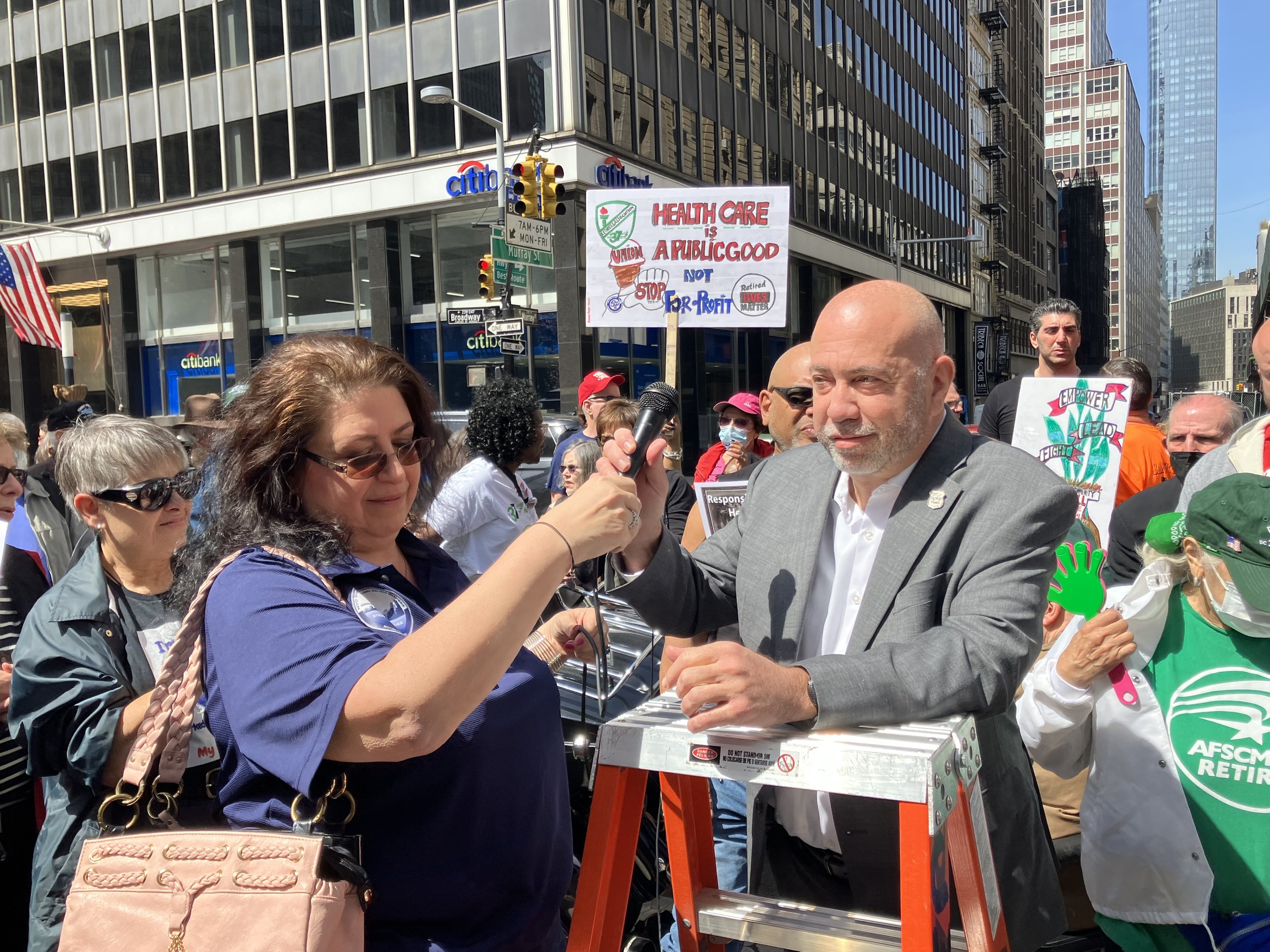Somebody Promised NYC Paramedics and EMTs Pay Parity…
New York City Mayor Eric Adams vowed to finally bring pay parity to civil servants who’ve been waiting for it since 1996. FDNY EMS Paramedic Jazmine Moore and her colleagues are holding Hizzoner to his word.
By Joe Maniscalco
Unbeknownst to most New Yorkers, the next time they call for help, the EMTs and Paramedics showing up to their rescue might’ve just spent a sleepless night in their cars wondering how they’re gonna cover an unexpected bill.
Emergency Medical Services (EMS) workers still climbing out of a catastrophic pandemic, which helped drive nearly 10 of them to suicide, are in crisis — and Mayor Eric Adams’ ongoing failure to finally deliver on the long sought-after pay parity he promised on the campaign trail is only compounding the pain.
“What my breaking point is or would be, I don't want to see,” EMS veteran Jennifer Aguiluz recently told Work-Bites. “I am afraid of what that would look like.”
The starting salary for FDNY EMTs is an incredible $18.94 an hour — that paltry sum for lifesaving work is less than the $19.96 an hour app-delivery drivers are supposed to get over the next couple of years. It takes FDNY EMTs five years just to get to $59K.
New York City’s “street doctors” are underpaid, overworked, disrespected and demoralized. They’ve watched the Adams administration settle contracts with virtually every other uniformed service in the city except them — and create a situation where the app-based delivery guys dropping off your dumplings are now actually on track to make more money than the people trying to save your life.
“We're the first people to arrive at a scene,” Aguiluz says. “And we’re also the first ones to leave because we do what we have to do and then leave. There is no glorification in that, and we’re not looking for that. But EMS here in New York City has been forgotten about — forever.”
Two separate ongoing class-action lawsuits against the City of New York are alleging wage discrimination on behalf of municipal EMTs, Paramedics and Fire inspectors — a federal court judge and the Equal Employment Opportunity Commission [EEOC] have found merit in both cases.
“The feds agreed with us that there is pay discrimination when it comes to EMS and Fire Inspectors,” FDNY EMS Local 2507 President Oren Barzilay told Work-Bites. “We represent the highest diversity group of people — that’s why we are paid the lowest.”
How much lower? Sixty-five percent lower than their first responders peers at the NYPD and FDNY, according to the union.
The city also continues to employ fewer than 4,500 EMS workers to answer S.O.S. calls from an ever-increasing population of 8.5 million inhabitants.
“I love my city,” Paramedic Jazmine Moore told Work-Bites. “But it's come to a point where we can’t even survive. Just last night, my child's father did an extra 10 hours after already working 12 hours. He's always on overtime. We barely see each other because if he's not on all the time — I'm on overtime. We're like two people passing each other — and we have a four-year-old. We're burning ourselves out because we have to do overtime to survive.”
City EMTs and Paramedics have been struggling to achieve pay parity with their first responder counterparts in the FDNY and NYPD since 1996 when NYC EMS first merged with the Fire Department.
Carlos Lizcano has been has been serving the City of New York since 1993.
Not only did the merger not result in pay parity, EMS workers argue it largely has gone on to function as a “backdoor to the FDNY,” siphoning off good EMTs and Paramedics, while eliminating the career paths into medicine that used to exist, and also contributing much to what Barzilay calls a “stratospheric” turnover rate.
“I'm good at what I do,” EMS veteran Carlos Lizcano told Work-Bites. “I want me to take care of me if something happens. But the only way that you could feel that way is if you have the time and the experience. We have so many EMTs, so many Paramedics who have less than five years on the job. It's worrisome.”
THE LOOK OF “IMPENDING DOOM”
“Institutional knowledge” certainly comes in handy when you arrive at the doorstep of someone who’s nearly had his head taken off with a machete.
That’s the bloody “horror show” Aguiluz walked into early in her EMS career. Despite her training and skill, she could have lost it if not for the steadying presence of her partner at the time — a seasoned veteran with more than decade on the job.
“Her leadership and her being calm put me in a place where I did my job better,” Aguiluz says. “Today, you can be anywhere in the five boroughs, call 911 and you have an EMT that has one year on the job — and their partner has two years on the job.”
That lack of experience, Aguiluz argues, puts the public in real danger.
"That’s not to say that they're not trained enough, or they're not capable enough, or not equipped enough mentally — I’m not saying that. But because of the retention problem that we have, you basically have two new people on the job performing that job,” she says.
Before Covid, Lizcano would respond to one or two — maybe three cardiac arrest calls a month. During the pandemic, however, he was running into six or seven cardiac arrest cases — per day.
“It was horrible,” he says.
Despite their best efforts to save everyone they encounter, city Paramedics and EMTs often come to recognize the face of “impending doom” — and it’s something they do not shake off.
Aguiluz remembers first seeing it in the face of a woman who had just been gravely injured in a vehicular accident some years ago.
“I was working the southeast part of Queens, you know? Somewhere around St. Albans, near the Rockaways…that whole area over there. I’m not sure when this was, but we get there and she’s laying on her stomach. She…I looked at her and immediately I knew she was in great danger as soon as we turned her over. We got her into the back of the ambulance, and that’s when she got even worse. She’s now complaining of abdominal pain — her last words were, ‘Can you call my son…?’”
“And the thing is,” Lizcano says, “you know, Joe Public? To them, we're just ambulance drivers. They don't understand that there's more to us than just picking up someone when they’re sick, throwing them into an ambulance, and taking them to the hospital.”
Lizcano explains, “We have to stabilize them — we have to make sure that they can make that trip to the hospital. There are things that we have to do [to make that possible]. You have a patient who's overdosing on heroin, we have to treat them [right there]. You have a patient who's having a heart attack, if we don't give them specific drugs, if we don't look at the EKG to take them to the appropriate hospitals so that they can get the appropriate care, they die.”
Moore was a brand new mom with a little baby at home trying to cope with runaway fears of infection when Covid first hit New York City hard.
“I was struggling,” she says. “I was having panic attacks left and right. It was my coworkers who were there for me and who kept me sane. They were like, ‘Jazmine, we’re family. We got this.’ So, that's what kept me here and still fighting for pay parity. And I'm not leaving until we get it.”
“A MAN OF THE PEOPLE?”
Coming out of the NYPD, the EMTs and Paramedics Work-Bites spoke to, said they fully expected Eric Adams to be the guy who finally delivered pay parity to EMS workers.
He talked a lot about it on the campaign trail.
Eric Adams vowed to bring pay parity to FDNY EMS workers once he was mayor in this Tweet sent out on June 4, 2021.
After receiving EMS’ endorsement two years ago, then candidate Adams said, “For years our EMTs, paramedics & fire inspectors have been shamefully denied pay parity — that comes to an end when I become Mayor.”
Now, however, Aguiluz, says EMS workers have heard “nothing but crickets” out of the Mayor’s Office.
“He has not come through on anything that he said that he would fix,” she says. “We’re now two years in — and there's been nothing.”
When asked for a comment, a spokesperson for City Hall told Work-Bites, “EMS workers have made countless sacrifices throughout the pandemic to keep New Yorkers safe, and we are deeply grateful for their efforts. We hope to reach a voluntary agreement with them that is fair to workers and taxpayers.”
FDNY EMS Local 2507 President Oren Barzilay rallied with New York City Organization of Public Service Retirees President Marianne Pizzitola and hundreds of other municipal retirees fighting to save their traditional Medicare benefits last April. Photo by Joe Maniscalco
Moore is continuing to hold Mayor Adams at his word.
“When you were running for office, you said quite a few times that EMS deserves pay parity. So, I just hope you are a man of your word,” she says.
After being on the job for 30 years, and working through some of the darkest days ever to descend on New York City, Lizcano counts himself as a realist who never put much stock in campaign rhetoric.
“I know that politicians are going to say what they need to say and they're going to back you up because it looks good,” he says. “Come on, man — you’d be an idiot not to back up EMS with what just happened during the pandemic — with everybody and their mother clapping for us. You'd be an idiot not to make promises.”
New York City municipal retirees fighting the adminstration’s ongoing efforts to strip them of their traditional Medicare benefits and push them into a profit-driven Medicare Advantage plan run by Aetna are certainly familiar with Eric Adams saying one thing on the campaign trail and doing another thing once in office.
Barzilay is one of the few union labor leaders in New York City — Laborers Local 924 President Kyle Simmons is another — who has stepped up and actually rallied alongside municipal retirees in the streets.
Lizcano is still angry, however, about the lack of pay parity and the lack of respect it demonstrates.
“When it's a hot job, Fire is in there, PD’s in there — but so are we,” he says. “When it's a hot job, and the firefighter gets hurt, or a police officer gets hurt, they want us — so why is it when now we need help, we can't be seen in the same light? Why are we not getting the same respect? We put ourselves in the same type of danger that they do. I can't say the amount of times, literally, guns are being drawn above me while I am treating a shooting victim. I've done it.”
According to Barzilay, New York City is losing between 15 and 20 EMS workers — weekly.
“We are a group of people who want to make a difference with people we've come in contact with,” he says. “However, they realize that after two, three years that there's no future here with the pay. Thirty percent of our workforce leaves after three years. Fifty percent of of them leave after five years. So, it’s a revolving door. We hire anywhere between 500 to 600 people every year because nobody wants to stay here. You can go to Walmart, Target, Mcdonald’s — and now even a delivery driver [job]. People have a vision, people want to make money, pay their bills — and this is not it.”
This is not the first time Work-Bites has reported on hard-pressed civil servants sleeping in their cars because the traveling back home for a short turnaround costs too much and just doesn’t make much sense. In September, we wrote how “long commutes to work,” were forcing some bus operators on the West Coast to sleep in their cars between shifts — “narrowing the gap between what used to be a ‘great middle-class job’ and the tens of thousands of people and their families forced to live on the street.”




